Watchtime Wednesday: Twelve Milestone Seiko Watches

Monochrome readers already know that we have a thing for Seiko. A brand that is mainly know, among the general audience, for their affordable quartz watches, has some magnificent timepieces in the collection. We’re big fans of the rugged SKX007, the perfect daily beater as Ilias described is his hommage. However we’re also very much impressed by Seiko’s groundbreaking work on hi-beat movements (see the first part of Evan’s 2-part hommage here), the Grand Seiko line and of course the Japanese pinnacle of watchmaking as delivered by Credor in the shape of the Credor Node Spring Drive Minute Repeater.
Our friends from Watchtime had the good fortune to visit Seiko in Japan and now they joined us in enthusiasm for this Japanese watch brand that delivers from affordable Seiko 5 models (remember our quest to find the cheapest high-end watch?) to aforementioned Credor Minute Repeater. Watchtime listed twelve milestone Seiko watches from Seiko’s impressive history of watchmaking, stretching all the way back to the late 19th century, and includes several watch-world firsts.
Seikosha Timekeeper (1895)

Seiko founder Kintaro Hattori was only 21 years old when he opened the K. Hattori watch and clock shop in Tokyo’s Kyobashi district and began building and repairing watches and clocks. He was only 31 when he partnered with an engineer named Tsuruhiko Yoshikawa to set up the Seikosha watch factory, forerunner of today’s Seiko, in 1892. After several years of producing high-quality wall clocks, Seikosha released its first pocketwatch, called simply the Timekeeper, in 1895. The 54.9-mm silver case was made in Japan, but most of the 22-ligne movement was imported from Switzerland. The English name “Timekeeper” was a product of Hattori’s shrewd business sense, as he realized that such a name would expand future export possibilities for the product.
Laurel (1913)
Hattori quickly recognized the growing worldwide popularity of the wristwatch and predicted that the demand for wristwatches would shortly outpace that for pocketwatches. Hence the debut of the Laurel in 1913, just 11 years after the first Hattori wall clocks. The Laurel had a silver case, 29.6 mm in diameter, a porcelain enamel dial, and a 12-ligne movement. At first, the need to import components meant that production was slow — just 30 to 50 pieces per day — but by 1910, Seikosha had managed to produce its own balance springs and by 1913, its own enamel dials.
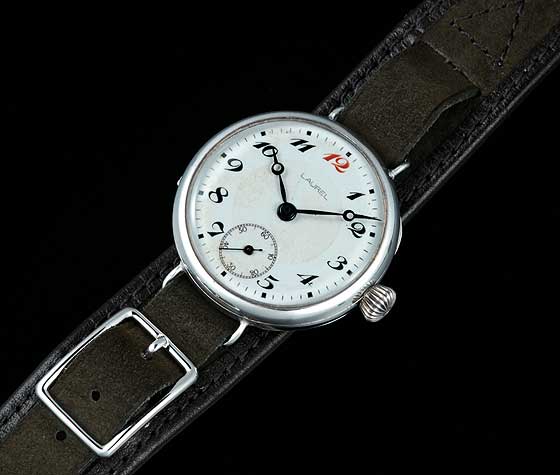
First Seiko Watch (1924)
The Great Kanto Earthquake struck Japan in 1923, destroying the Seikosha factory and stocks and halting production of timepieces. However, the determined Hattori decided to quickly rebuild, despite the massive costs, and only one year later the world was introduced to the very first watch with the name “Seiko” on the dial. (“Seiko” is, of course, an abbreviation of “Seikosha,” which means, roughly, “House of Exquisite Workmanship” in Japanese.) The use of a non-English name indicated that Hattori had become confident enough in the quality of his products that they would sell despite the widely held belief (at the time) that products made in the West were of superior quality. The watch had a 24.2-mm case made of nickel and a 9-ligne, 7-jewel movement. Its small seconds subdial was standard all the way up until 1950, when the Seiko Super debuted as the first Japanese watch with a central seconds hand.
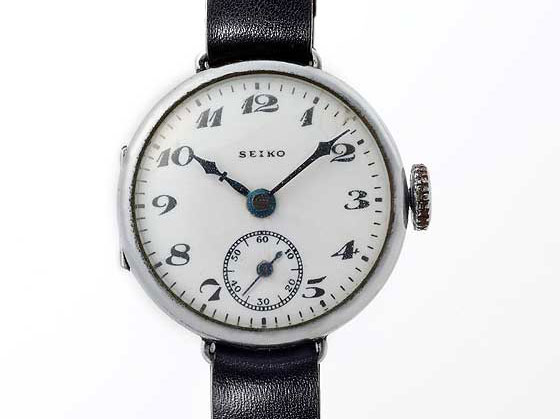
Seiko Marvel (1956)
Seiko considers the Seiko Marvel to be an epoch-making watch in its history, as it is the first Seiko watch whose movement was designed “fully in-house from scratch” — i.e., not influenced by other watch movements made in Switzerland or elsewhere. The movement diameter (26 mm) was larger than that of the Seiko Super (and matched the dimensions of the Seiko Automatic, which debuted the same year and is notable for being Japan’s first automatic wristwatch). It’s accuracy and stability, which incorporated a new Seiko invention, the “Diashock” shock absorption system, was far superior to that of its predecessors as well as that of other Japanese watches of that era. The Seiko Marvel was produced until 1959, when it was superseded by the Seiko Gyro Marvel, which had a new automatic movement with Seiko’s “Magic Lever” mechanism that increased the winding efficiency.
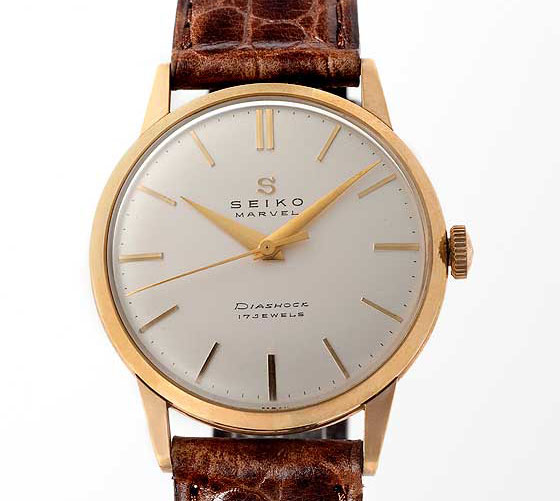
First Grand Seiko (1960)
This was the watch that Seiko created to be “the best in the world” in terms of accuracy and precision. The mechanical movement, Caliber 3180, measured 12 lignes and had 25 jewels and a frequency of 18,000 vph. The watch itself had a gold-filled case, 34.9 mm in diameter and 10 mm thick. Each Grand Seiko watch was certified with an original standard of precision that Seiko established (and which, today, is stricter in its criteria than even the Swiss agency COSC’s standard for certifying chronometers). The watch, with its clean dial, long hands and applied indices, established the design codes that Grand Seiko watches still adhere to today.
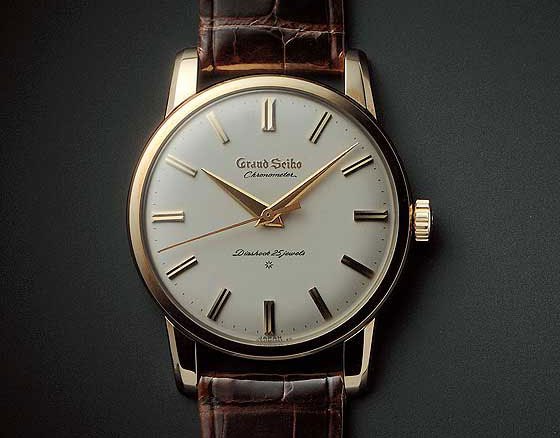
Seiko Crown Chronograph (1964)
With all of its previous accomplishments, it is not surprising that Seiko was also responsible for creating Japan’s first chronograph watch. Its story begins with the 1964 Olympic games, held in Tokyo, for which Seiko was the official timekeeper. Seiko provided more than 1,200 units of various types of stopwatches for the Olympic timers, and to commemorate the event, also issued a commercial version of its wristwatch chronograph, which had a monopusher system. The Seiko Crown Chronograph had a stainless steel case, 38.2 mm in diameter and 11.2 mm thick, and water-resistant to 30 meters. The movement was the 12-ligne, 21-jewel Caliber 5719.

Seiko Diver’s 150M (1965)
It was just one year after releasing the first Japanese-made chronograph that Seiko launched the first dedicated divers’ watch made in Japan, the Seiko Diver’s 150M. As its name implies, its stainless steel case was water-resistant to 150 meters, and measured 38 mm in diameter and 13.4 mm thick. The watch had a bidirectional rotating bezel and was fitted with the automatic Caliber 6217 (17 jewels, 18,000 vph). At the time, diving was a relatively rare hobby, so this was a very specialized product. As diving grew in popularity, Seiko continued to refine its dive watches. In 1968, it introduced a version with a high-beat movement (36,000 vph) and 300-meter water resistance. Its first Professional Diver’s watch in 1975 was water-resistant to 1,000 meters, and also the first dive watch with a titanium case; and another version of the Professional Diver’s in 1986 (the first with a unidirectional bezel) increased the water-resistance to 1,000 meters. Seiko’s in-house standards for its dive watches helped establish the ISO standards for dive watches that is still in use today.

Seiko 5 Sports Speed Timer (1969)
Nineteen sixty-nine was an important touchstone for the watch industry, as it was the year of what’s been dubbed “the great automatic chronograph race.” A handful of Swiss brands — and one notable Japanese one — vied to become the first manufacturer to produce and market a wristwatch chronograph watch with automatic winding. The results of this competition produced a number of watches that are today regarded as icons, such as the Breitling Chrono-Matic, Zenith El Primero, and Heuer Monaco. But the first of these automatic chronographs actually on the market (in May 1969, to be precise) was Seiko’s 5 Sports Speed Timer. The world’s first automatic chronograph equipped with both a vertical clutch and a column wheel, the 5 Sports Speed Timer had a 30-minutes counter, a tachymeter-scale bezel, and a day-date display with an innovative bilingual system: wearers could set it to read in English or Japanese. The movement, caliber 6139, beat at a high frequency of 21,600 vph and the 30-mm stainless steel case was water-resistant to 70 meters.
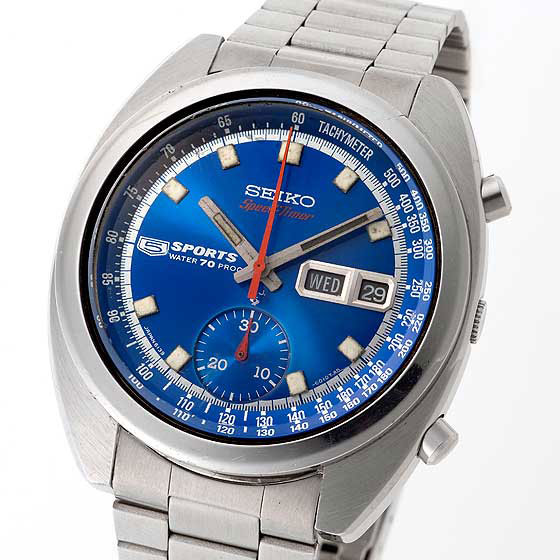
Seiko Quartz Astron (1969)
The very same year that Seiko was winning the race to the market for an automatic chronograph watch, it also unveiled the watch that at one point threatened to render all mechanical watches obsolete. The Seiko Quartz Astron, the world’s first quartz wristwatch, represented a groundbreaking technological breakthrough. The watch’s tuning-fork-shaped quartz oscillator gave the Astron’s movement, Caliber 35A, an amazing accuracy of just +/- 5 seconds per month, far greater than any mechanical movement. The movement’s small, thin, stepping motor conserved energy by moving the second hand only once per second, a new development for wristwatches. The oscillator proved to be very shock-resistant and worked at a very low voltage, ensuring a battery life of one full year. Interestingly, whereas quartz watches would develop a reputation as inexpensive timepieces for the masses, the first one was decidedly luxurious, boasting an 18k gold case.
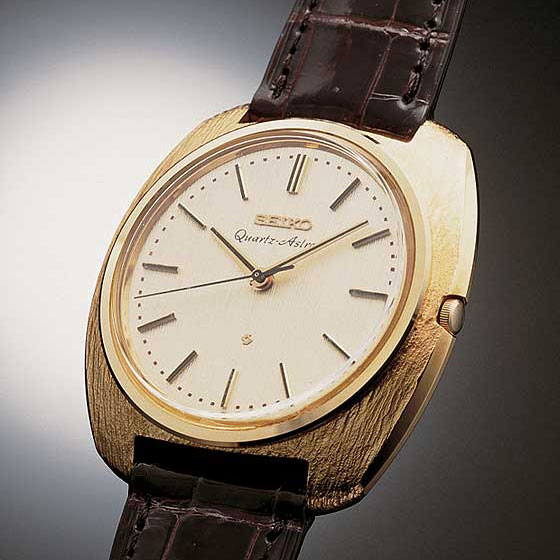
Seiko A.G.S. “Kinetic” (1988)
Seiko did not give up on mechanical watchmaking innovations and other types of technologies after it introduced its quartz watches. The brand introduced a solar-powered watch in 1977 and a quartz watch with hand-wound power generating in 1986. In 1988, it introduced a new technology that would help define the brand for the modern era for its Seiko A.G.S. (Automatic Generating System, which later become known as “Kinetic”), a watch whose movement had an oscillating weight that converted the motions of the wearer’s wrist into electricity that powered the quartz movement.
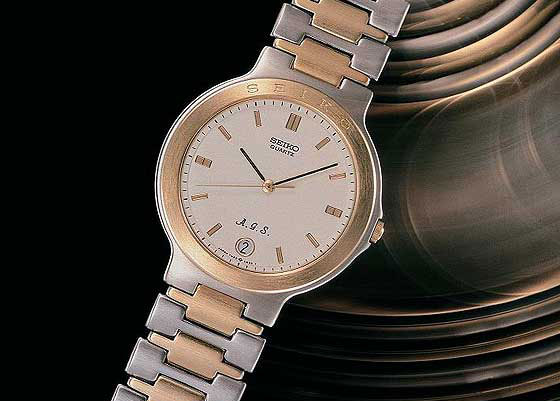
Seiko Spring Drive Spacewalk (2008)
Seiko introduced another new technology to the watch market in 1999, releasing the first watch with a “Spring Drive” movement, which has a quartz oscillator but is powered a mainspring like a mechanical watch. Since that debut, Spring Drive has found its way into numerous Seiko watches, including some modern versions of the Grand Seiko. Perhaps its most notable iteration is in the Spring Drive Spacewalk, which was specially commissioned by video-game mogul Richard Garriott, whose father was a NASA astronaut and Seiko wearer, and who, in October of 2008, visited the International Space Station (Garriott’s initial goal, which did not materialize, was to become the first civilian to walk in space, hence the model’s name.) The watch, which was limited to 100 pieces, was engineered specifically for space travel, with a specially designed gasket that made it extra airtight in frigid temperatures, a lightweight case made of high-intensity titanium, and a large dial with easy-to-read chronograph subdials and three times the amount of luminous material as on a standard luminous watch. Additionally, the large chronograph pushers were made to be easily operable by someone wearing the thick gloves of a spacesuit.
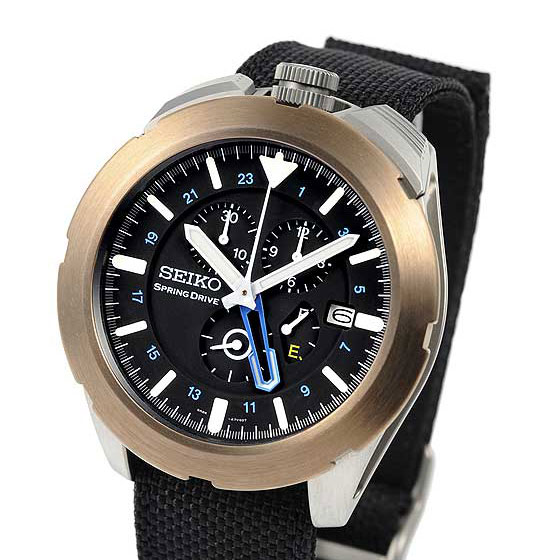
Seiko Astron GPS Solar (2012)
Seiko’s current CEO and President, Shinji Hattori (descendant of the founder), was sending a bold and unmistakable message when he opted to resurrect the name Astron for Seiko’s solar-powered GPS watch, launched to great fanfare at Baselworld 2012. Like the first Seiko Astron, which introduced the world to quartz timekeeping, the new Astron GPS Solar represented the debut of an entirely new and potentially game-changing watch technology. It is an analog, solar-powered watch that receives GPS satellite signals and adjusts to the precise local time anywhere on Earth. It recognizes all 39 time zones (mechanical world-time watches display only up to 37) and has a manual reset. The Astron covers the globe by first determining its location using GPS, then comparing that information with an onboard database that divides the Earth’s surface into one million squares, each of which is assigned to a particular time zone. The Astron’s system is superior even to those of radio-controlled watches, which receive terrestrial radio signals from atomic clocks, in that it automatically recognizes what time zone it is in. For much more on the Seiko Astron GPS Solar, click here to Watchtime’s review.

This article was published first by WatchTime and republished here with permission.




1 response
The Seiko quartz Astron in 1969 was perhaps the most important milestone of Seiko’s watchmaking history, and the Grand Seiko pushed their brand’s reputation to a much higher level